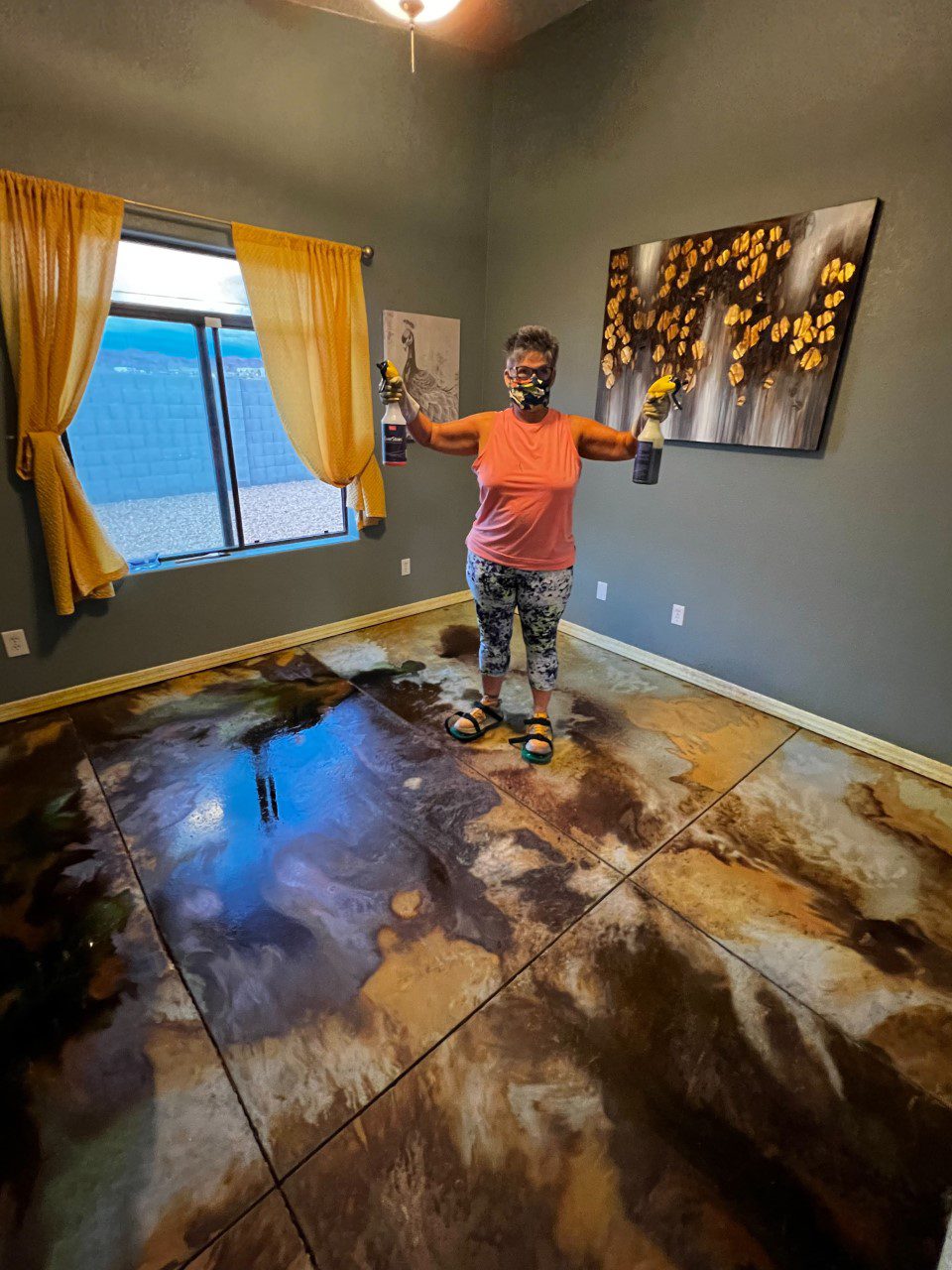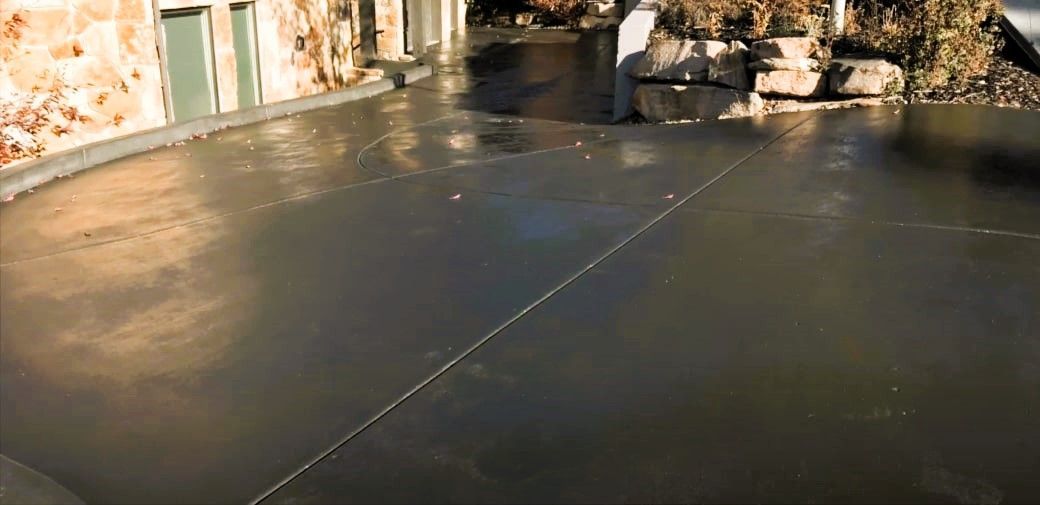Everything About Stained Concrete: A Comprehensive Guide to Its Benefits and Applications
Stained concrete has emerged as a preferred option for both residential and business areas. Its capacity to combine aesthetic charm with functionality makes it an appealing alternative. Different staining techniques offer a variety of shades and surfaces, permitting personalization. Nevertheless, the advantages prolong past look. Understanding its applications and upkeep needs is necessary for any person considering this flexible material. The subtleties of stained concrete invite even more expedition.
What Is Stained Concrete?

Staining can be applied to various surface areas, including floors, driveways, and patios, making it a flexible alternative for both indoor and outdoor areas. The therapy can accomplish a range of appearances, from natural tones to bold, contemporary designs. Unlike paint, stained concrete keeps its appearance with time, as it comes to be an indispensable part of the concrete itself. In general, stained concrete works as an effective technique for transforming average concrete into visually striking surfaces.
Benefits of Stained Concrete
Stained concrete offers considerable advantages, particularly in aesthetic allure and longevity - Stained Concrete Austin. Its lively colors and unique patterns enhance the visual charm of any type of space, making it a prominent choice for both residential and commercial applications. Furthermore, the longevity of stained concrete assurances that it remains a useful financial investment over time, standing up to wear and tear
Visual Appeal
Among the most compelling advantages of making use of stained concrete is its amazing visual appeal. Stained concrete offers a special and functional look that can match various layout styles, from modern to rustic. The mixture of vibrant shades and intricate patterns allows homeowners and developers to create customized surfaces that can boost the overall atmosphere of a room. Unlike standard flooring alternatives, stained concrete can simulate the look of natural rock or sleek marble, providing an upscale look without the associated expenses. Additionally, the glossy surface choices can show light, more brightening insides. This flexibility makes stained concrete a popular choice for both household and commercial applications, where visual impact is extremely important.
Resilience and Long life
The outstanding visual high qualities of stained concrete are complemented by its amazing toughness and longevity - Stained Concrete Floors Austin. Stained concrete surfaces are immune to deterioration, making them appropriate for high-traffic locations both inside your home and outdoors. Their durable nature implies they can withstand rough climate condition, including extreme temperatures, rainfall, and UV direct exposure, without substantial degradation. On top of that, stained concrete needs marginal maintenance compared to various other floor covering alternatives, as it does not need constant sealing or redecorating. This longevity not only lowers substitute expenses yet likewise adds to a lasting building approach. Overall, stained concrete offers a long-lasting remedy that integrates visual allure with functional benefits, ensuring its value in time
Various Kinds of Staining Techniques
Various discoloration techniques can significantly influence the aesthetic qualities of concrete surfaces. The three key approaches consist of acid staining, which responds chemically with the concrete, water-based staining, which offers a broader array of shades, and overlay staining alternatives that provide a fresh surface. Each method has special qualities and applications that provide to various design choices and task needs.
Acid Staining Technique
Just how can home owners change ordinary concrete surfaces right into aesthetically striking functions? One efficient method is acid discoloration, a popular strategy that boosts the natural elegance of concrete. This procedure entails applying a remedy of water, hydrochloric acid, and metallic salts to the concrete surface area. As the acid reacts with the lime existing in the concrete, it produces rich, variegated colors that resemble marble or stone. Acid staining is recognized for its longevity and resistance to fading, making it a long-lasting choice for both interior and outside applications. However, it is vital to keep in mind that the outcomes can differ based upon the original concrete shade and appearance - Stained Concrete Floors Austin. Correct application and sealing are vital for attaining the preferred aesthetic and longevity
Water-Based Discoloration Strategy
A preferred option to acid discoloration, the water-based discoloration technique offers house owners a versatile means to enhance concrete surface areas. This method uses water-soluble dyes and pigments, permitting a vast array of colors and finishes. Unlike acid discolorations, water-based discolorations can be put on unsealed concrete and offer a much easier cleaning process. The results can accomplish a more uniform appearance and can be layered to produce special impacts. Additionally, water-based spots are generally much less hazardous and release fewer unpredictable natural compounds (VOCs), making them much more eco-friendly. Home owners may appreciate the ability to customize their concrete surfaces with numerous shades, enabling for imaginative expression while maintaining longevity and long life in their floor covering selections.
Overlay Discoloration Options
Countless overlay staining alternatives exist for homeowners looking to rejuvenate their concrete surface areas. One prominent option is acid discoloration, which responds chemically with the concrete to create rich, variegated colors. One more alternative is water-based discoloration, supplying a wider color palette and less complicated application. Furthermore, concrete overlays can be integrated with stencils for detailed designs, improving visual appeals. For a much more distinctive finish, homeowners might think about making use of stamped overlays that simulate all-natural materials like stone or tile. Each strategy offers one-of-a-kind advantages, from durability to customization, enabling an individualized touch. Inevitably, the choice of overlay staining depends on the desired appearance and the condition of the existing concrete, making certain a revitalized and appealing surface area.
Applications of Stained Concrete
Stained concrete offers a flexible service for Source various applications, improving both visual appeal and functionality. This product is generally used in property, commercial, and industrial setups, making it a popular choice amongst designers and designers. In homes, stained concrete can serve as elegant flooring or outside patio areas, offering a sophisticated appearance while staying sturdy.
In business rooms, such as retail stores and dining establishments, stained concrete adds to a contemporary setting and can stand up to heavy foot traffic. In addition, stained concrete is increasingly made use of in public spaces like parks and pathways, where its capability to imitate natural stone or various other materials includes aesthetic interest.
Stained concrete is excellent for swimming pool decks and driveways, supplying a slip-resistant surface area that is easy to preserve. Generally, the flexibility of stained concrete makes it ideal for many environments, dealing with varied preferences and needs.
Maintenance and Care for Stained Concrete
Correct maintenance guarantees the longevity and beauty of stained concrete surfaces. Regular cleansing is essential; making use of a mild detergent and water with a soft-bristle brush helps eliminate dirt and grime without damaging the coating. It is advisable to avoid severe chemicals that can remove the tarnish or sealer.
Securing stained concrete is vital for protection against wetness, discolorations, and use. A high-grade sealer must be reapplied each to three years, relying on the traffic and exposure the surface area withstands. Furthermore, addressing spills quickly will stop discoloration and discoloration.

Price Considerations for Stained Concrete Projects
When intending a discolored concrete job, spending plan factors to consider play an essential role in identifying the general cost. The expenses related to stained concrete can differ substantially based on a number of factors. The size of the area to be stained straight influences material and labor expenses. Bigger rooms will naturally need even more sources. Second, the kind of discolor picked-- acid-based or water-based-- can influence rates, with acid spots usually being extra costly. Furthermore, the intricacy of the style, including patterns or several shades, can enhance labor costs. Preparation job, such as cleansing and grinding the concrete surface, adds to the preliminary expenditures also. Lastly, the option in between do it yourself installment and employing a specialist contractor will certainly additionally affect the spending plan. Understanding these elements makes it possible for house owners to make educated financial choices regarding their stained concrete tasks, ensuring they achieve the desired aesthetic within their economic means.
Tips for Selecting the Right Stained Concrete for Your Space
Selecting the appropriate stained concrete for a details room involves careful reflection of various variables beyond simply great post to read budget. Initially, one should examine the designated use of the area. High-traffic areas might need even more sturdy coatings, while attractive applications can prioritize aesthetics.
The shade palette is an additional important facet; the selected shades need to harmonize with existing style and lighting. It's also essential to consider the surface area appearance, as smooth finishes can improve sophistication, while distinctive choices might assure safety and security in wet locations.
Local environment and environmental problems play a substantial function in the durability and maintenance of stained concrete, affecting the choice of sealers and finishes.
Lastly, seeking advice from experts can provide useful insights customized to details demands, guaranteeing the selection of the suitable stained concrete that lines up with both performance and design.

Regularly Asked Concerns
Can Stained Concrete Be Applied Over Existing Floor Covering?
Stained concrete can indeed be applied over existing flooring, supplied the surface is steady and appropriately prepared. This technique permits for an aesthetic upgrade without the demand for complete elimination of the initial floor covering products.
How Much Time Does Stained Concrete Last?
Stained concrete can last for decades when appropriately maintained. Variables such Recommended Site as website traffic, environmental problems, and application methods considerably affect its durability, with several installments remaining dynamic and intact for 10 to three decades.
Is Stained Concrete Slippery When Damp?
Stained concrete can be slippery when wet, as the surface might create a smooth surface. Using non-slip ingredients or textured surfaces can minimize this problem, enhancing security without jeopardizing the aesthetic allure of the concrete.
Can I Discolor Concrete Myself, or Should I Employ an Expert?
The decision to tarnish concrete personally or hire a specialist depend upon ability level and project complexity. While do it yourself discoloration can conserve money, professionals guarantee suitable results, particularly for complex layouts or big surfaces.
What Color styles Are Available for Stained Concrete?
The range of colors available for stained concrete includes earthy tones like browns and tans, vibrant shades such as reds and blues, and softer colors like pastels. This palette enables innovative, personalized layout choices.